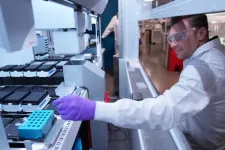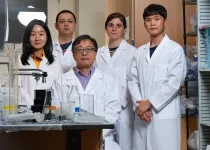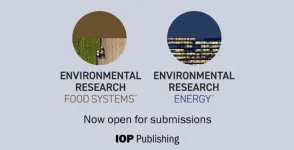(Press-News.org) Life on Earth didn’t arise as described in textbooks
No, oxygen didn’t catalyze the swift blossoming of Earth’s first multicellular organisms. The result defies a 70-year-old assumption about what caused an explosion of oceanic fauna hundreds of millions of years ago.
Between 685 and 800 million years ago, multicellular organisms began to appear in all of Earth's oceans during what's known as the Avalon explosion, a forerunner era of the more famed Cambrian explosion. During this era, sea sponges and other bizarre multicellular organisms replaced small single-celled amoeba, algae and bacteria, which until then, had had run of the planet for more than 2 billion years.
Up until now, it was believed that increased oxygen levels triggered the evolutionary arrival of more advanced marine organisms. This is being disproved by University of Copenhagen researchers working together with colleagues from Woods Hole Oceanographic Institute, the University of Southern Denmark and Lund University, among others.
By studying the chemical composition of ancient rock samples from an Omani mountain range, the researchers have been able to "measure" oxygen concentrations in the world's oceans from when these multicellular organisms appeared. Defying expectations, the result shows that Earth’s oxygen concentrations had not increased. Indeed, levels remained 5-10 times lower than today, which is roughly how much oxygen there is at twice the height of Mount Everest.
"Our measurements provide a good picture of what average oxygen concentrations were in the world's oceans at the time. And it’s apparent to us that there was no major increase in the amount of oxygen when more advanced fauna began to evolve and dominate Earth. In fact, there was somewhat of a slight decrease," says Associate Professor Christian J. Bjerrum, who has been quantifying the conditions surrounding the origin of life for the past 20 years.
Revises our understanding of life’s origins
The new result puts to rest a 70-year research story that advances the centrality of higher oxygen concentrations in the development of more advanced life on our planet.
"The fact that we now know, with a high degree of certainty, that oxygen didn’t control the development of life on Earth provides us with an entirely new story about how life arose and what factors controlled this success," says the researcher, adding:
"Specifically, it means that we need to rethink a lot of the things that we believed to be true from our childhood learning. And textbooks need to be revised and rewritten."
There remains much that the researchers don't know, as well as and a plethora of controversy. Therefore, Bjerrum hopes that the new result can spur other researchers around the world to reconsider their previous results and data in a new light.
"There are many research sections around the world, including in the United States and China, that have done lots of research on this topic, whose earlier results may shed important new details if interpreted on the basis that oxygen didn’t drive the development of life," says the researcher.
Absence of oxygen may have aided development
So, if not extra oxygen, what triggered the era’s explosion of life? Perhaps the exact opposite, explains the researcher:
"It’s interesting that the explosion of multicellular organisms occurs at a time with low concentrations of atmospheric and oceanic oxygen. That indicates that organisms benefited from lower levels of oxygen and were able to develop in peace, as the water chemistry protected their stem cells naturally," says Christian J. Bjerrum.
According to the researcher, the same phenomenon has been studied in cancer research, in the stem cells of humans and other animals. Here, colleagues at Lund University observed that low oxygen levels are crucial for keeping stem cells under control until an organism decides that the cell ought to develop into a specific type of cell, such as a muscle cell.
"We know that animals and humans must be able to maintain low concentrations of oxygen in order to control their stem cells, and in so doing, develop slowly and sustainably. With too much oxygen, the cells will develop, and in the worst case, mutate wildly and perish. It is far from inconceivable that this mechanism applied back then," concludes Christian J. Bjerrum.
Box 2: Fossils from Oman
In the new study, the researchers analysed rock samples from, among other places, the Oman Mountains in northern Oman. While quite high and very dry today, the mountains were on the seabed during the Avalon explosion’s rapid blossoming of organism diversity.
The researchers have had their findings confirmed in fossils from three different mountain ranges around the world: the Oman Mountains (Oman), Mackenzie Mountains (NW Canada) and the Yangtze Gorges area of South China.
Over time, clay and sand from land are washed into the sea, where they settle into layers on the seabed. By going down through these layers and examining their chemical composition, researchers can get a picture of ocean chemistry at a particular geologic time.
The analyses were performed using Thallium and Uranium isotopes found in the mountains, which the researchers were able to extract data from, and in doing so, calculate oxygen levels from many hundreds of millions of years ago.
Contact:
Christian J. Bjerrum
Associate Professor
Department of Geosciences and Natural Resource Management
University of Copenhagen
Phone: + 45 35 32 24 05
mail: cjb@ign.ku.dk
Michael Skov Jensen
Journalist and team coordinator
The Faculty of Science
University of Copenhagen
Mobile: + 45 93 56 58 97
Mail:msj@science.ku.dk
END
Life on Earth didn’t arise as described in textbooks
No, oxygen didn’t catalyze the swift blossoming of Earth’s first multicellular organisms. The result defies a 70-year-old assumption about what caused an explosion of oceanic fauna hundreds of millions of years ago.
2023-07-18
ELSE PRESS RELEASES FROM THIS DATE:
This is what relatives think about home-based hospital care
2023-07-18
Relatives are a great resource in today's healthcare system. In Norway, relatives' efforts add up to approximately the same number of person-years as provided by the public municipal health and care services.
But the role of relatives is changing. Changes in the age composition of the population, changed social structures and family patterns will affect how many relatives each of us has to support us in the future.
In order to look after relatives in the best possible way, it is necessary to have increased knowledge about relatives' involvement and the need for support in various ...
Howard and Susan Elias make $16.25 million gift to fund cancer neuroscience research at MD Anderson
2023-07-18
HOUSTON ― The University of Texas MD Anderson Cancer Center today announced a
$16.25 million gift from Howard and Susan Elias to accelerate brain tumor and cancer neuroscience research, an emerging field focused on integrating the role of the nervous system in cancer. Howard Elias’ son, Harrison, was diagnosed with brain cancer and underwent successful surgery in 2000. Six years earlier, Howard’s father had died of glioblastoma. These separate diagnoses sparked a giving program over the years, leading to this latest gift which represents ...
Allen Institute for Immunology partners with Lilly to better understand autoimmune disease
2023-07-18
SEATTLE — July 18, 2023 — In a significant milestone for the Allen Institute for Immunology, a division of the Allen Institute, researchers and staff will collaborate with private industry researchers to aid in the detailed molecular understanding of disease, in service of developing new treatments and therapies to improve human health.
Specifically, Allen Institute scientists will work with researchers from Eli Lilly and Company (Lilly) to investigate and profile disease state diversity and biomarkers for drug response involving atopic dermatitis (eczema) and rheumatoid arthritis using Allen Institute-developed ...
Using AI to speed up vaccine development against Disease X
2023-07-18
CEPI, the Coalition for Epidemic Preparedness Innovations, and the Houston Methodist Research Institute (HMRI), have today announced a partnership to combine cutting-edge artificial intelligence (AI) technology with established laboratory techniques to speed up development of future vaccines against novel viral threats (also known as Disease X). HMRI will lead a consortium including experts from Argonne National Laboratory (University of Chicago), J Craig Venter Research Institute, La Jolla Institute, The University of Texas Medical Branch, and The University of Texas, ...
Japanese beetles could spread throughout Washington state in 20 years
2023-07-18
PULLMAN, Wash. – Without intervention, the colorful but devastating Japanese beetle could make its way across the evergreen state within two decades, according to a study of their potential dispersion.
The iridescent, green-and-copper beetles damage plants by “skeletonizing” their leaves, chewing up all the soft green parts between the veins. They eat over 300 plants and pose a serious threat to Washington agriculture as some of their favorite crops include grapes, hops and cherries.
Once established, Japanese beetles are tough to eradicate, but it may be possible to keep them under control, said David Crowder, a Washington State University entomologist.
“These ...
Will artificial intelligence (AI) end civilization? Lero researchers seek public's views on AI and software
2023-07-18
Will artificial intelligence (AI) end civilisation? Researchers at Lero, the Science Foundation Ireland Research Centre for Software and University College Cork, are seeking help determining what the public believes and knows about AI and software more generally.
Psychologist Dr Sarah Robinson, a senior postdoctoral researcher with Lero, is asking members of the public to take part in a ten-minute anonymised online survey to establish what peoples’ hopes and fears are for AI and software in general.
“As the experts debate, little attention is given to what the public thinks – and the debate is raging. Some ...
NIH grant backs Rice U. lab’s sickle cell disease research
2023-07-18
HOUSTON – (July 18, 2023) – Rice University bioengineer Gang Bao and his team have won a 4-year, $2.6 million grant from the National Institutes of Health to address critical questions surrounding the safety and efficacy of using gene editing to treat sickle cell disease.
Because it is caused by a mutation in a single gene, sickle cell disease is a prime candidate for gene editing treatments using tools such as CRISPR-Cas9.
“Sickle cell disease affects over five million people worldwide, and ...
EMBARGOED: Women less likely to be routed to comprehensive stroke centers for large vessel acute ischemic stroke, according to UTHealth Houston research
2023-07-18
Despite having worse stroke symptoms and living within comparable distances to comprehensive stroke centers, women with large vessel occlusion acute ischemic stroke are less likely to be routed to the centers compared to men, according to a new study from UTHealth Houston.
Led by corresponding author Sunil Sheth, MD, associate professor of neurology and director of the vascular neurology program with McGovern Medical School at UTHealth Houston, and senior author Youngran Kim, PhD, assistant professor of management, policy, and community health with UTHealth Houston School of Public Health, the study was published today in the Journal of the American ...
IOP Publishing’s latest Environmental Research series journals now open for submissions
2023-07-18
IOP Publishing’s (IOPP) new environmental research journals are now open for submissions. Announced earlier this year, the two new open access (OA) journals: Environmental Research: Energy and Environmental Research: Food Systems are the latest additions to IOPP’s expanding Environmental Research Series which now includes eight open access titles.
IOPP’s Environmental Research series builds on the established reputation of the journal Environmental Research Letters (ERL) and shares the same outstanding levels of author service, inclusive editorial policies, strict quality assurance and has open science principles at its core.
IOP ...
This sugar kills honeybees—it could also help fight cancer
2023-07-18
LA JOLLA, CALIF. – July 18, 2023 –Research from Sanford Burnham Prebys and the Osaka International Cancer Institute has shed new light on the anti-cancer properties of mannose, a sugar that is crucial to many physiological processes in humans and is also known to inhibit the growth of cancer cells. The findings, published in the journal eLife, suggest that mannose could be a helpful secondary treatment for cancer.
“This sugar could give cancer an extra punch alongside other treatments,” says study co-author Hudson Freeze, Ph.D., director of the Human Genetics ...
LAST 30 PRESS RELEASES:
Global burden and mortality of amyotrophic lateral sclerosis and other motor neuron diseases in 204 countries and territories, 1990–2021
Research into zoonotic disease risks requires a One Health approach
The seamounts of Cape Verde: a biodiversity hotspot and a priority for marine conservation in the central-eastern Atlantic
Scientists uncover how a mitochondrial mutation rewires immune function
Do children imitate communication manners of machines? Experiment on children's response to polite vs. commanding robot
Tiny traps, big trouble: Small regions within cells aggregate proteins linked to ALS, dementia
The future of type 1 diabetes: Can stem cells provide a cure?
UBC researchers uncover how statins harm muscles—and how to stop it
SwRI tackles pre-ignition challenges in hydrogen-fueled engines
Making LAZY plants stand up: Research reveals new pathway plants use to detect gravity
HBNU researchers propose novel sensor-integrated wrapper for food quality monitoring and preservation
Role of ubiquilin-2 liquid droplets in α-synuclein aggregation
Hanyang University researchers proposed novel technology for environmental infringement and sag estimation for transmission lines
Pro fighters risk damage to the brain’s ‘garbage disposal’
AI tops density in predicting breast cancer risk
Pesticides and other common chemical pollutants are toxic to our ‘good’ gut bacteria
Chemists design OLEDs that electrically flip the handedness of light
Experimental mRNA therapy shows potential to combat antibiotic-resistant infections
New mutation hotspot discovered in human genome
New deep-learning tool can tell if your salmon is wild or farmed
If you're over 60 and playing with sex toys, you're not alone
Fame itself may be critical factor in shortening singers’ lives
Daily coffee drinking may slow biological ageing of people with major mental illness
New highly efficient material turns motion into power – without toxic lead
The DEVILS in the details: New research reveals how the cosmic landscape impacts the galaxy lifecycle
After nearly 100 years, scientists may have detected dark matter
Gender imbalance hinders equitable environmental governance, say UN scientists
Six University of Tennessee faculty among world’s most highly cited researchers
A type of immune cell could hold a key to preventing scar tissue buildup in wounds
Mountains as water towers: New research highlights warming differences between high and low elevations
[Press-News.org] Life on Earth didn’t arise as described in textbooksNo, oxygen didn’t catalyze the swift blossoming of Earth’s first multicellular organisms. The result defies a 70-year-old assumption about what caused an explosion of oceanic fauna hundreds of millions of years ago.





